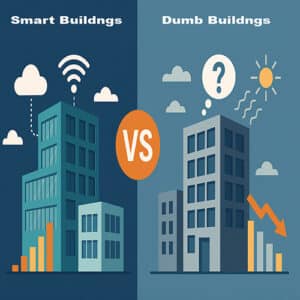We’ve all seen it: buildings with lights blazing in empty rooms, HVAC systems running full blast after hours, and maintenance crews scrambling when something finally breaks. These aren’t just minor inefficiencies — they’re symptoms of what the industry often calls dumb buildings.
And while that term might sound harsh, it highlights a critical reality: buildings that aren’t designed to think — or at least react — end up quietly costing far more than you’d expect.
On the flip side, smart buildings use technology to work with you, not against you. They respond in real time, conserve energy, and make facilities easier (and cheaper) to run. Yes, they come with an upfront price tag. But when you stack up the numbers, smart buildings don’t just pay for themselves — they outperform in every category that matters.
Let’s break down the real costs behind both paths.
What Makes a Building “Smart”?
A smart building uses integrated technologies — sensors, automation, analytics, and AI — to control and optimize systems like lighting, HVAC, window shades, and even space usage. Everything is connected, responsive, and working toward a single goal: better performance.
At MHT Technologies, we design and deploy smart infrastructure using Power over Ethernet (PoE) and intelligent software like aida™, which brings it all together — lights, shades, sensors, and control — on one seamless platform.
Smart buildings don’t just do more — they make better decisions, in real time.
What’s a “Dumb” Building, Exactly?
“Dumb” buildings rely on manual controls, siloed systems, and outdated infrastructure. They lack data, automation, and situational awareness. You can’t optimize what you can’t see — and that’s the real problem.
Think about how often:
- Lights stay on in unused rooms
- Thermostats blast AC into empty conference spaces
- No one knows how often certain areas are used — or underused
- You only find out something’s wrong after it breaks
It adds up. Quietly. Consistently. Expensively.
Smart Tech Costs More… at First
Yes, let’s be honest — smart building upgrades require investment. From running PoE cabling and installing sensors to setting up automation software and integrating shading systems, you’re likely looking at a 5%–10% increase in project costs upfront.
But that’s the start of the story — not the end. Because unlike legacy infrastructure, smart systems begin paying off the moment they’re activated.
The Hidden Costs That Dumb Buildings Hide
What seems “cheaper” on day one can turn out to be far more expensive over time. Here’s how older, non-automated buildings quietly burn money:
Request a quote, schedule a demo, or simply get in touch!
 Energy Waste
Energy Waste
When systems run without context — heating, cooling, and lighting spaces regardless of occupancy — it’s like burning cash. Smart buildings can reduce energy usage by up to 30%, simply by responding to actual conditions.
High Maintenance Costs
Break/fix models cost more in the long run. Smart buildings use predictive maintenance to catch problems before they escalate — saving time, parts, and labor.
Underused Space
Are you lighting and cooling areas no one’s using? Without occupancy data, most organizations are. Smart analytics help you optimize space and reduce unnecessary overhead.
Poor Indoor Experience
Uncomfortable temperatures, stale air, and bad lighting don’t just frustrate people — they impact productivity, well-being, and retention. Smart buildings adjust dynamically to create healthier, more human-centric environments.
Missed Revenue & Value
Buildings that don’t meet modern expectations are harder to lease, less attractive to investors, and often miss out on energy incentives or certifications like LEED or WELL.
Real Returns, Not Just Hypotheticals
When done right, smart buildings often see a full return on investment in just 2–5 years. In many cases, it’s even faster when you factor in:
- Utility savings
- Reduced maintenance calls
- ESG reporting ease
- Longer equipment lifespan
- Tenant or employee satisfaction
At MHT, we’ve seen clients immediately benefit from lower install costs (thanks to PoE), reduced HVAC loads (with automated shading), and real-time dashboards that uncover hidden inefficiencies.
Smart buildings also align with LEED green building standards — and in fact, many of their features can directly contribute to certification.
Bottom Line: Smart Is the Investment. Dumb Is the Liability.
Here’s the truth: every building costs you something. The only question is whether it’s returning that value — or bleeding it out over time.
Smart buildings invest in performance. They give you visibility, control, and the ability to adapt. Dumb buildings, by contrast, lock you into rising utility bills, blind spots, and missed opportunities.
If you’re planning new construction, considering a retrofit, or just trying to get more out of the space you already have, there’s never been a better time to make the shift.
